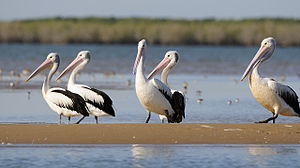Lake Yamma Yamma
[1] The lake only holds water following major floods on Cooper Creek.
When dry, the lake bed's cracking grey clay soils support extensive grasslands dominated by rat's tail couch.
[1] The lake, with its associated seasonal claypans and the nearby Barrolka Lakes to the north-east, has been identified by BirdLife International as a 1,218 km2 (470 sq mi) Important Bird Area (IBA) because it has supported over 1% of the world populations of plumed whistling-ducks, sharp-tailed sandpipers and Australian pelicans, as well as providing habitat for Australian bustards.
[3] A large colony of Australian pelicans breeds on an island at the north-eastern end of the lake.
Other birds recorded in substantial numbers include hardheads, white-headed stilts, glossy ibises, grey teals, black-tailed nativehens, Australian pratincoles, whiskered terns and Pacific black ducks, with smaller numbers of freckled ducks and white-winged black terns.
